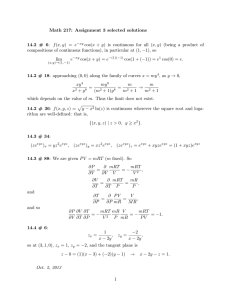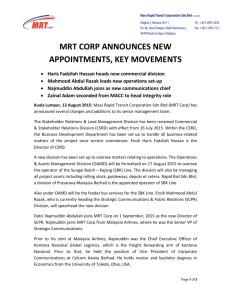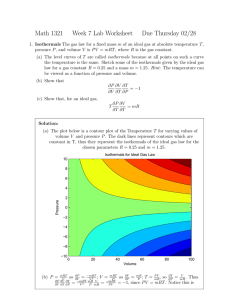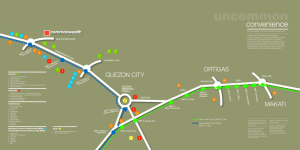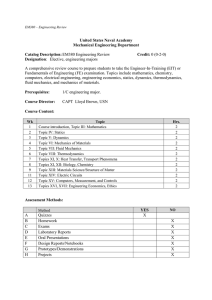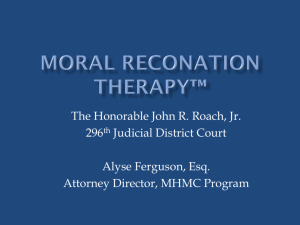Results of Implementing a Computer-based Mechanics Readiness Program in Statics*
advertisement
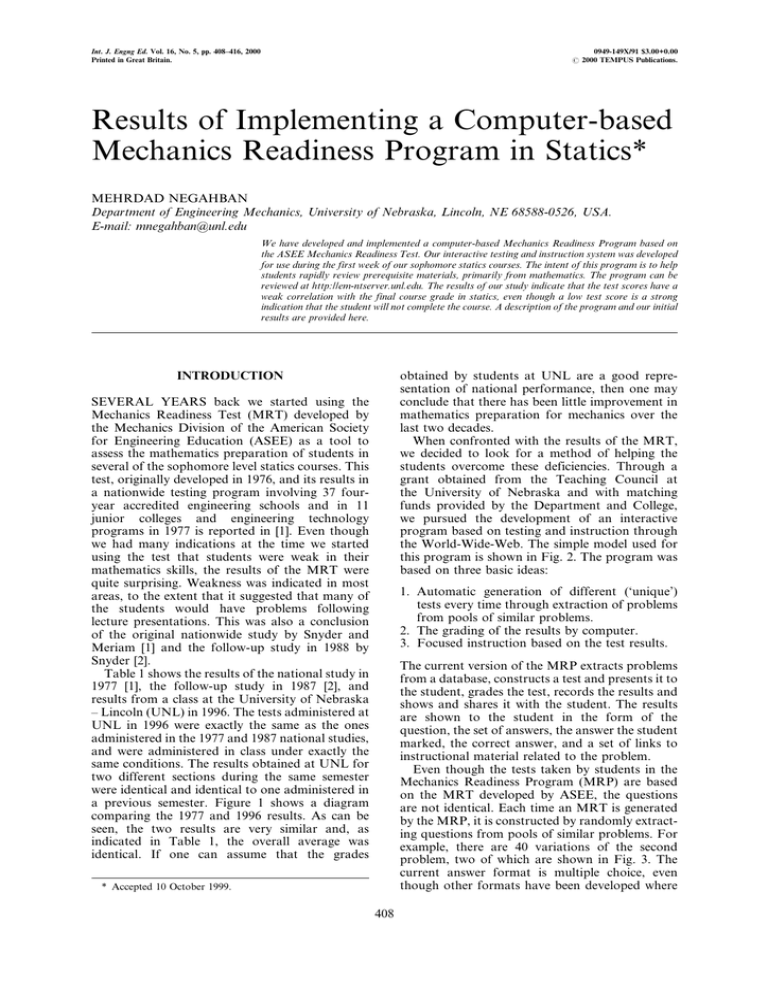
Int. J. Engng Ed. Vol. 16, No. 5, pp. 408±416, 2000 Printed in Great Britain. 0949-149X/91 $3.00+0.00 # 2000 TEMPUS Publications. Results of Implementing a Computer-based Mechanics Readiness Program in Statics* MEHRDAD NEGAHBAN Department of Engineering Mechanics, University of Nebraska, Lincoln, NE 68588-0526, USA. E-mail: mnegahban@unl.edu We have developed and implemented a computer-based Mechanics Readiness Program based on the ASEE Mechanics Readiness Test. Our interactive testing and instruction system was developed for use during the first week of our sophomore statics courses. The intent of this program is to help students rapidly review prerequisite materials, primarily from mathematics. The program can be reviewed at http://em-ntserver.unl.edu. The results of our study indicate that the test scores have a weak correlation with the final course grade in statics, even though a low test score is a strong indication that the student will not complete the course. A description of the program and our initial results are provided here. obtained by students at UNL are a good representation of national performance, then one may conclude that there has been little improvement in mathematics preparation for mechanics over the last two decades. When confronted with the results of the MRT, we decided to look for a method of helping the students overcome these deficiencies. Through a grant obtained from the Teaching Council at the University of Nebraska and with matching funds provided by the Department and College, we pursued the development of an interactive program based on testing and instruction through the World-Wide-Web. The simple model used for this program is shown in Fig. 2. The program was based on three basic ideas: INTRODUCTION SEVERAL YEARS back we started using the Mechanics Readiness Test (MRT) developed by the Mechanics Division of the American Society for Engineering Education (ASEE) as a tool to assess the mathematics preparation of students in several of the sophomore level statics courses. This test, originally developed in 1976, and its results in a nationwide testing program involving 37 fouryear accredited engineering schools and in 11 junior colleges and engineering technology programs in 1977 is reported in [1]. Even though we had many indications at the time we started using the test that students were weak in their mathematics skills, the results of the MRT were quite surprising. Weakness was indicated in most areas, to the extent that it suggested that many of the students would have problems following lecture presentations. This was also a conclusion of the original nationwide study by Snyder and Meriam [1] and the follow-up study in 1988 by Snyder [2]. Table 1 shows the results of the national study in 1977 [1], the follow-up study in 1987 [2], and results from a class at the University of Nebraska ± Lincoln (UNL) in 1996. The tests administered at UNL in 1996 were exactly the same as the ones administered in the 1977 and 1987 national studies, and were administered in class under exactly the same conditions. The results obtained at UNL for two different sections during the same semester were identical and identical to one administered in a previous semester. Figure 1 shows a diagram comparing the 1977 and 1996 results. As can be seen, the two results are very similar and, as indicated in Table 1, the overall average was identical. If one can assume that the grades 1. Automatic generation of different (`unique') tests every time through extraction of problems from pools of similar problems. 2. The grading of the results by computer. 3. Focused instruction based on the test results. The current version of the MRP extracts problems from a database, constructs a test and presents it to the student, grades the test, records the results and shows and shares it with the student. The results are shown to the student in the form of the question, the set of answers, the answer the student marked, the correct answer, and a set of links to instructional material related to the problem. Even though the tests taken by students in the Mechanics Readiness Program (MRP) are based on the MRT developed by ASEE, the questions are not identical. Each time an MRT is generated by the MRP, it is constructed by randomly extracting questions from pools of similar problems. For example, there are 40 variations of the second problem, two of which are shown in Fig. 3. The current answer format is multiple choice, even though other formats have been developed where * Accepted 10 October 1999. 408 Results of Implementing a Computer-based Mechanics Readiness Program in Statics 409 Fig. 1. Comparison between the 1977 national study [1] and MRT results at UNL in 1996. Table 1. Comparison between the national results in 1977 [1], 1987 [2] and UNL results in 1996 Problem Subject of question % Correct 1996 1987 1977 5 6 7 8 9 10 11 12 13 14 15 16 17 18 19 20 21 22 23 24 25 26 27 Pythagorean theorem for right triangles Right triangles, elementary trigonometry The law of sines and cosines and basic trig relations The basic trigonometric identities Small angle approximations of trig functions Basic geometry and trigonometry Equation of a line Geometry, a line intersecting parallel lines Three dimensional geometry, trigonometry Equations of basic geometric shapes Equation of a circle Basic properties of a circle The area of basic geometric objects Relationship between similar triangles The principal of volume, pressure and specific weight The concept of mass The approximation of area Vector algebra Dot product Cross product Differentiation and the chain rule Area under a curve by integration The slope of a curve using derivatives Average 97 67 23 93 50 30 43 87 20 33 53 90 73 33 50 63 47 76 50 40 20 73 53.2 1996 94 72 21 92 57 42 53 91 43 43 63 93 75 41 64 60 30 65 42 39 47 75 58.0 1987 93 67 19 87 47 37 43 88 42 38 49 88 73 35 63 57 28 59 37 33 35 66 52.7 1977 Fig. 2. Flow chart of the MRP. 410 M. Negahban Fig. 3. Example of two variations of Question 2. a student can input a number, equation, n-tuple, etc. These other options are not yet completely implemented. In addition to randomly extracting from pools of similar questions, the order of appearance of the answers for each Multiple Choice question on the MRP is randomly selected for each test so that even if a student gets the same problem, more than likely the answers will not be in the same order. Access to the MRP is through the World-WideWeb and can be done from any location connected to the Web. The test can be taken under proctored or unproctored formats. For a test to be recorded as proctored, a student must visit the Department laboratory, where the laboratory attendant verifies the identity of the student and proctors the test. The instruction portion of the MRP currently consists of several elements. After taking the test, the student is provided with an overall score, and a copy of all problems the student was given. Each problem is marked as correct or incorrect. If a question is marked incorrectly, there will be an indication of the answer selected by the student, the correct answer, and a list of links to pages containing review materials on related subjects. The student may also browse the review material through a list organized by subject. To date, the MRP has been administered in two different formats. The first format is very close to the original MRT developed by ASEE, and has 24 questions on the topics shown in Table 2. The second format has calculus-related questions removed from the test to make it appropriate for the non-calculus version of statics (taught to students of Architecture and Construction Management at UNL). This version of the test has only 14 questions. Over 600 students took the MRP in the 1997±98 and 1998±99 academic years, and over 1000 tests were generated and graded under the MRP in this period. Over 1500 MRTs Table 2. Results of the Mechanics Readiness Test for Spring 1998 Problem Subject of question 1 2 3 4 5 6 7 8 9 10 11 12 13 14 15 16 17 18 19 20 21 22 23 24 Pythagorean theorem for right triangles Right triangles, elementary trigonometry The law of sines and cosines and basic trig relations The basic trigonometric identities Small angle approximations of trig functions Basic geometry and trigonometry Equation of a line Geometry, a line intersecting parallel lines Three dimensional geometry, trigonometry Equations of basic geometric shapes Equation of a circle Basic properties of a circle The area of basic geometric objects Relationship between similar triangles The principal of volume, pressure and specific weight The concept of mass The approximation of area Vector algebra Dot product Cross product Differentiation and the chain rule Area under a curve by integration The slope of a curve using derivatives and the chain rule Solution to a quadratic equation Average % Correct First time Last time 92.4 67.0 39.2 63.3 43.0 31.7 60.8 89.9 50.6 49.4 44.3 79.8 60.8 64.6 64.6 74.7 39.2 68.4 40.5 30.4 69.6 65.8 55.7 51.9 94.9 77.2 46.8 74.7 57.0 39.2 74.7 91.1 58.2 53.2 62.0 82.3 62.0 70.9 72.2 88.6 55.7 67.1 53.2 43.0 77.2 77.2 60.8 70.9 58.23 67.09 Results of Implementing a Computer-based Mechanics Readiness Program in Statics 411 Fig. 4. Typical multiple choice question and answer set. were administered in the 1996±97, 1997±98, and 1998±99 academic years, either in a proctored or unproctored setting, and either in class or by computer. The scope of the MRT is restricted to very elementary topics of geometry, trigonometry, analytic geometry, vector algebra, and calculus. For example, Problem 13 is a multiple choice question that asks the student to identify the equation for calculating the area of simple geometric objects (rectangle, triangle, trapezoid, parallelogram, circle, or ellipse) from a set of five options. Or, for example, Question 20 is one of several variations on the question shown in Figure 4. ADMINISTRATION OF THE TEST Currently the MRT is administered in two ways. A student can either take the test without a proctor under the demonstration version or the student can take it in the Engineering Mechanics computer laboratory under proctored conditions. To take the demonstration version of the test the student can log onto our server from any location connected to the Web and need not generate a personal account. In this way the identity of the student is unknown to us when taking the demonstration version. This allows the students the opportunity to experiment with the test without needing to provide their identity. The demonstration version of the test is generated from the same pool of questions as the proctored version so that students see tests very similar to the ones they will take when they come for the proctored test. The proctored test is conducted in the Engineering Mechanics computer laboratory and the scores from these tests were those that were used for this study. The proctors in the laboratory are responsible to check the identity of the students. They are also responsible to make sure the students do not use notes, books, calculators, etc. Even though the students are not allowed to use anything during the test, they are allowed as much time as they want on a given test. If they are not satisfied with the results of their test, they can request a new test. The new test is generated (as each test administered by the MRP is) from pools of similar problems so that the student frequently sees a totally new set of problems on the new test, even though they will be similar to those they have previously seen. The students may take the MRT as many times as they wish during the first week of classes. The MRT was optional in the Fall of 1997, but starting with the Spring of 1998 it has become part of the overall course grade. Typically, the MRT score is included in the final course grade as equivalent to one homework assignment or quiz, depending on the grading practices of the instructor. To motivate repeated use of the MRT and use of the instructional component of the MRP, only the highest grade on the MRT is used towards the course grade. Starting with the Fall of 1998, an upgrade to the MRP was implemented that enhanced the ease of accessing instructional materials. TEST RESULTS The results of the tests given during the Fall and Spring semesters of the 1997±98 and 1998±99 academic years are summarized in Table 3. In this table EM 220 refers to the course number 412 M. Negahban Table 3. Overall performance on the Mechanics Readiness Test for the 1997±98 and 1998±99 academic years Course Semester No. of tests administered EM220 1997-98 Fall Spring 109 69 No Grade No Grade EM223 1997-98 Fall Spring 131 126 No Grade No Grade First time for all Final time for all First time for multi-users Second time Final time for multi-users Improvement for multi users Points in score Percent Course Semester No. of tests administered 56 56 17 17 17 48.6 53.3 39.7 54.8 66.7 92 92 23 23 23 27.0 68% 13.0 24% EM223 1998-99 Fall 344 No Grade 168 64.4 168 73.2 80 66.1 80 76.6 80 84.8 First time for all Final time for all First time for multi-users Second time Final time for multi-users Improvement for multi users Points in score Percent 41.6 47.0 39.5 52.1 57.1 17.6 45% EM220 1998-99 Fall 70 No Grade 49 56.7 49 64.7 14 54.1 14 78.1 14 82.1 28 52% 52 52 9 9 9 Spring 66 No 43 43 12 12 12 Grade 53.0 59.6 51.8 65.5 75.6 23.8 46% for the non-calculus version of statics, EM 223 is the calculus based statics, and EM 250 is a special half-semester course offered for Electrical Engineers. As described above, the students were allowed to take the test as many times as they wanted. For each course and each semester, Table 3 shows: 1. The average score of all students based on the first time they took the test. 2. The average score of all students on their last try (if a student selected not to retake the test, the first score was taken as the last score). 3. The average score on the first try of only the students that took the test multiple times. 4. The average score of the students on the second try. 5. The average score based on the final attempt for all students that took the test multiple times. Also included in this table is the total number of tests administered, the total number of students taking the test, and the number of students associated with each score presented. In general, overall there were only about 3±9 points improvement in performance when including all students. Yet, there was, on average, anywhere from a 7 to 24-point increase (13% to 45% improvement of grade) from the first to second MRT score for those students that took the test a second time. Also, there was, on average, anywhere from a 13 to 28-point increase (22% to 68% improvement of grade) from the first to last MRT score of the students that took the test more than once. This indicates that substantial improvement on the MRT score was achieved using the MRP. It is not yet clear how much of this improvement is due to familiarization with the test format and how much a result of engaging in the instruc- 53.4 56.7 53.3 60.3 66.3 18.7 28% 79 79 32 32 32 58.2 67.1 53.7 70.6 75.5 21.8 41% Spring 178 No 79 79 46 46 46 EM250 1997-98 Fall Spring 37 No Grade No Grade Grade 68.7 77.9 65.8 74.0 81.5 15.7 24% 22 22 8 8 8 EM250 1998-99 Fall 21 No Grade 18 68.75 18 71.76 3 70.8 3 88.9 3 88.9 18.1 26% 76.5 81.9 65.6 72.4 80.2 14.6 22% Spring 23 No 13 13 4 4 4 Grade 62.8 71.2 55.2 80.2 82.3 27.1 49% tional component of the MRP. Since the tests given in the Fall of 1997 were not mandatory, as opposed to those administered later, there should have been more incentive in the Spring of 1998 for students to continue with the instruction portion of the MRP and to take the test for a second or third time. This was not necessarily true if one looks at the number of tests administered, but the average performance on the MRT did improve when the MRP was made mandatory. Also, the average performance on the MRT has been steadily rising. This might partially be a result of the better access provided to the instructional materials that occurred with the implementation of the new version of the MRP for the Fall semester of 1998, and might partially be due to the implementation of a demonstration version that the students can practice on without providing their identity. Particularly, the rise of the score for the first try may be directly a result of the addition of the demonstration version since as many demonstration versions of the MRT were administered during the 1998±99 academic year as were administered under proctored conditions (over 1000 demonstration tests administered). Part of the improvement might also be associated with providing better incentives for students to improve their score and better promotion of this activity by the instructor. The performance on specific questions for the normal calculus-based statics course (EM 223) during the Spring semester of 1998 is shown in Table 3. In this table the average performance is recorded for each question based on both the first and last time a student took the test, as described above. As can be seen, less than 60% of the students correctly marked questions 3, 5, 6, 9, 10, 11, 17, 19, 20, 23, and 24. Other than Question 20 Results of Implementing a Computer-based Mechanics Readiness Program in Statics 413 Fig. 5. Problems students consistently showed difficulty in. that is shown in Fig. 4, one variation of each on of these questions are shown in Fig. 5. There were variations from semester to semester in the overall performance on particular questions. For example, there was also difficulty with problems 14 and 15 in the Fall of 1997. The performance of students on the MRT is correlated to the final course grade in Fig. 6. A linear regression and 70% confidence brackets indicate that there is a correlation between the highest grade a student gets on the MRT and their course grade, even though this correlation is weak due to the wide distribution of grades. Since the data is overlaid in Fig. 6, Fig. 7 shows the same 414 M. Negahban Fig. 6. Correlation between final course grade and highest grade on the MRT (A 4, B 3, C 2, D 1, F 0). results in terms of average grade for all students receiving the same MRT score and one standard deviation brackets. A point to note is that all students who obtained a grade above 70% on the MRT also passed the course. There were a large number of students (about 30%) that took the MRT, but were not on the final grade roster since they withdrew from the course early in the semester. These students and any students receiving a grade of W (Withdraw) are not included in Figs 6 and 7 since they did not have a course grade. The average performance of this group was 33% on the MRT with a standard deviation of 22%. This suggests that even if the MRT does not strongly correlate with the final grade a student receives in statics, a grade below 50% is a strong indicator that a student will not complete the course. The seemingly better (anomalous) performance shown in Figs 7 and 8 for the students getting low MRT grades (between 30% and 35%) is due to the fact that there were no letter grades for the students that withdrew from the course. Since there was no letter grade for these students, their performance is not included in the figures. It is anticipated that if the students who withdrew from the course had continued with the course and obtained a letter grade, the figures would show less variation at the lower end of the scale. Figure 8 shows the course grade of students that took the MRT more than once only for those who did not drop the course. A surprising result is that these students achieved, on average, a 3.5 (B+) grade point in the course, with very little correlation to their MRT score. One explanation may be that these students showed their persistence by taking the MRT more than once and this same persistence results in better performance in the course. The average course grade for all students who completed statics was 2.9 (<B). COMMENTS AND CONCLUSIONS Even though the MRP has not yet been proven to be a powerful tool for eliminating mathematics Fig. 7. Correlation between final course grade and highest grade on the MRT showing average course grade and standard deviation for all students obtaining the same MRT score (A 4, B 3, C 2, D 1, F 0). Results of Implementing a Computer-based Mechanics Readiness Program in Statics 415 Fig. 8. Course grade of students that took the MRT more than once. deficiencies in the background of students that enter statics, the students that take the MRT multiple times show substantial improvement in their test scores (22%±68% improvement of their score). This improvement is achieved within less than one week. There is a weak correlation between the MRT score and the final course grade. A low MRT score is a strong indicator that the student will not complete the course. It is not clear that helping the students increase their MRT score will result in better performance in the course. Yet, the students who took the initiative to take the MRT more than once did substantially better than those who did not. The results of the two previous studies [1, 2] and the current paper all indicate that there is substantial deficiency in the mathematics preparation of the students. The intention of developing the MRP was to help students rapidly overcome these deficiencies, which is now being reflected in much higher MRT scores for the Fall of 1998 and the Spring of 1999. With this in mind, we are now looking at developing a similar program with Statics content to be administered during the first week of dynamics or strength of materials. As the base for this program we are looking at the Statics Competency Test developed by Morris and Kraige [3] and its re-evaluation by Rosati [4]. It is probably more important to provide students with methods and incentives to rapidly review prerequisite materials and to remove any existing deficiencies, than it is for us to test their knowledge on these subjects. In most cases the tests are simply a part of this review process, and frequently indicate what we already know about the preparation of the students. As part of this process of review, the MRP needs to be integrated with incentives to motivate students to use it, something we are now appreciating more and more. The Fall of 1998 and Spring of 1999 results indicate about 10% improvement in overall student performance. This was partially due to better connection to the instructional component in the MRP, partially due to providing more incentives for students to engage in the instructional portion and to improve their grades, and partially due to more intensive faculty support. AcknowledgmentsÐThe author acknowledges the help of Russell Froehlich and thanks him for developing and implementing the MRP, and for collection of the data presented on the MRT. The author also acknowledges the support of the Teaching Council, the Department of Engineering Mechanics, and the College of Engineering at the University of Nebraska. The author thanks the faculty of the Department for participating in the MRP. REFERENCES 1. V. W. Snyder and J. L. Meriam, A study of mathematical preparedness of students: The Mechanics Readiness Test, Eng. Educ., (December 1977) pp. 261±264. 2. V. W. Snyder, Mechanics Readiness Test: revisited, 1988 ASEE Annual Conf. Proc., Portland, Oregon, (1988) pp. 1345±1349. 3. D. H. Morris and L. G. Kraige, Results of a Statics Competency Test, 1985 ASEE Annual Conf. Proc., Atlanta, Georgia, (1985) pp. 1366±1370. 4. A. P. Rosati, Probing the Statics Competency Test, 1988 ASEE Annual Conf. Proc., Portland, Oregon, (1988) pp. 1323±1330. 416 M. Negahban Mehrdad Negahban obtained his BS (1982) in Mechanical Engineering from Iowa State University of Science and Technology, his MS (1984) and Ph.D. (1988) in Applied Mechanics from the University of Michigan. Since 1989 he has been at the University of Nebraska, and is currently an Associate Professor of Engineering Mechanics at this institution. His areas of interest, other than mechanics education at the undergraduate level, are in continuum mechanics and thermodynamics, plasticity, thermomechanical modeling of polymers and simulation of their processing.
